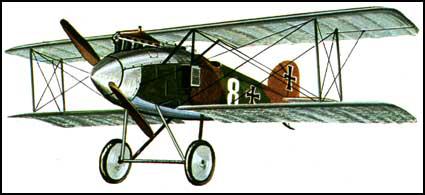The Western Front
In 1914 Ernest Heinkel designed the Albatros BII for the German Albatros Werke company. The plane soon set an altitude record of 14,764 feet (4,500 m) and was employed as a reconnaissance craft during the early stages of the First World War.
The company then employed Robert Thelen to produce the Albatros D-I. It was the first German fighter to have two synchronized fixed machine-guns without damaging its flying ability. The Albatros D-I went into action in the autumn of 1915. It was soon joined by an improved version, the Albatros D-II. At the time it was the best performing aircraft on the Western Front and gave the Central Powers a distinct advantage over the Allies.

Performance Data of the Albatros D-II | |
|---|---|
Type | fighter |
Engine | 160 hp Mercedes |
Wing Span | 27 ft 10 in (8.5 m) |
Length | 24 ft 3 in (7.4 m) |
Height | 8 ft 6 in (2.95 m) |
Maximum Speed | 109 mph (175 kph) |
Maximum Height | 17,060 ft (5,200 m) |
Endurance | 1 hour 30 minutes |
Armament | 2 machine-guns |
